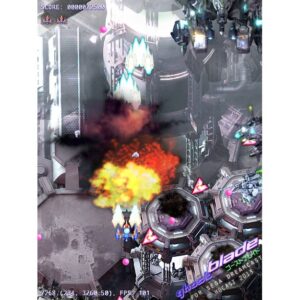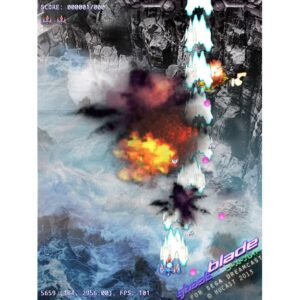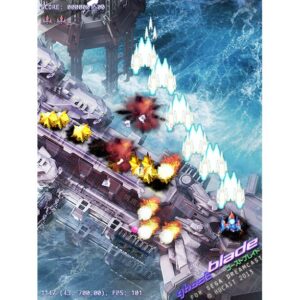
It’s been almost a decade and a half since the Dreamcast’s official discontinuation, but the fairly iconic white-and-grey box is still going strong with unlicensed game releases. Among the most popular genres on the system, even during its official lifespan, were shmups. This hasn’t changed much after the Dreamcast’s death, with games like Fast Striker, DUX, and NEO XYX being released years after Sega’s console development days came to an end.
Ghost Blade is a vertically-scrolling shoot-em-up in the same vein as many others before it, being developed in-house and published by Hucast games. They’re also responsible for developing games like DUX and Redux, as well as publishing a few titles from Orion Games. Their previous releases have seen some divisive reviews, but I’m happy to say Ghost Blade is a genuinely fun game–with a few caveats.
I’ll start by saying it was a bit of a treat to have to dig out my Dreamcast for this game. I honestly haven’t used the thing in a year or two, and there was a good deal of nostalgia associated with breaking it out again for a brand new title. The game opens with a declaration of, “It’s Still Thinking,” a staple phrase among new releases for the old system, which is an homage to the marketing campaign chosen by Sega when the console was still alive and kicking.
Next, you’re tasked with picking one of three provocatively-dressed pilots, who each have different ships and firing patterns. The art for them is quite good, and it’s pretty nice to have variety, especially when dealing with a game you’ll likely be replaying several times over. Once you’ve done so, you’re thrown into the first level, and get an initial glimpse at the gameplay.
Ghost Blade has two tiers of difficulty, Novice and Normal. Novice difficulty deploys a bomb (if you have one) when you’re about to take fatal damage, preventing you from losing a life. However, even on Normal difficulty, I had very little trouble with this game. The only times I died were due to the enemy projectiles being a little difficult to see, or when the game would occasional suffer from a drop in framerate. Funnily enough, these are two of my biggest complaints about Ghost Blade.
The gameplay is fairly standard for a vertically-scrolling shmup, with a few variations. For one, you have two modes of fire–a broad pattern of bullets that hits multiple enemies at once, and a sort of focus-fire attack. When defeating an enemy, the former gives you points toward your overall score, while the latter gives you upgrades for your weapon systems. This becomes more crucial in co-operative play, when your jerkoff friend takes all your weapon boosts when you die.
Your bomb essentially clears all the mooks on the screen, as well as the bullets they’re shooting at you. Again, this is standard fare for games like this, but the animation for the bomb is pretty weird. It’s just a screen-wide explosion, and is over in a second or two. Perhaps this was due to the game being rushed, or some cutbacks, but there are certainly cooler bomb effects in other games.
The visuals are something I’m fairly torn on. While the character art and ship designs are top-notch, the backgrounds and projectiles are a bit lackluster. The golden tokens you collect to raise your score are a little too big, and they tend to distract from the ridiculous amounts of bullets flying around. All in all, the presentation is just a little muddy, and that can be a problem in a game where visual clarity is pretty damned important.
Thankfully, the soundtrack comes through in the clutch, delivering some toe-tapping electronic tunes to accentuate your bullet-dodging escapades. I usually don’t listen to soundtracks included with games, but Ghost Blade is certainly an exception. Music is a pretty subjective art form, but I doubt many people will be dissatisfied with the sound design in this title. It can be slow and atmospheric, or fast-paced and frenetic. All-in-all, I have very few complaints.
Going up against games like Ikaruga, Triggerheart Exelica, and Giga Wing can be pretty difficult. Comparing Ghost Blade against these iconic titles is a bit unfair, but the juxtaposition is inevitable. However, I think it does manage to occupy a niche, being a fairly accessible danmaku title. It might just be the best entry point for bullet hell shooters that one could hope for, being easy enough to beat in one sitting, yet displaying the mechanics one would expect in a more hardcore shmup.
If you’ve got a Dreamcast already, and are interested in getting into bullet hell games, Ghost Blade comes highly recommended. Similarly, if you’re looking to engage in a little nostalgia and dust off an old console, I’d also suggest you give it a try. It’s a genuinely fun game, despite its problems, and a pretty entertaining co-op experience to boot. It’s not a game that’s going to make you go out and buy a Dreamcast if you don’t already own one, but it’s certainly a nice addition to any collector’s lineup.
Ghost Blade was reviewed on the Sega Dreamcast using a physical copy provided by Hucast Games. You can find additional information about Niche Gamer’s review/ethics policy here.
The Verdict: 7.5
The Good:
- Great artwork and awesome ship designs.
- Killer soundtrack with bumpin’ tunes!
- Generally fun mechanics with satisfying danmaku patterns.
- Very accessible for newbies to the genre.
- It’s on Dreamcast! How cool is that?
The Bad:
- Enemy bullets can be a bit difficult to see.
- There aren’t any additional difficulty modes, so people looking for further challenge will be disappointed.
- Graphics can be a bit muddy at times.
- Slowdown is an occasional issue.
- Game is pretty short, with only five levels that go by fairly quickly.
- It’s on the Sega Dreamcast, which is a hard sell for someone who doesn’t own one.



